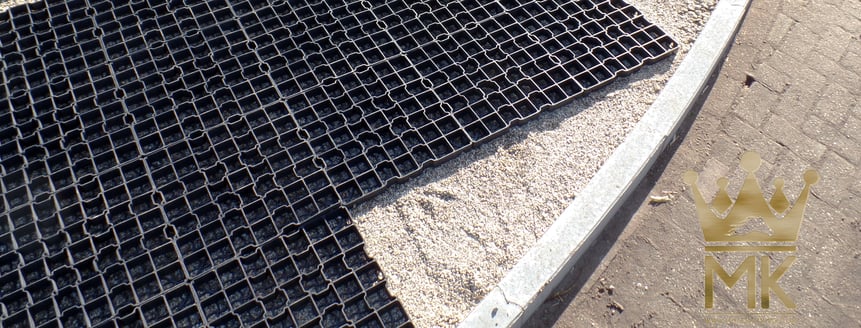Why the horse walker floor is the most underrated component

The horse walker floor is an essential part of a horse walker. But what should you pay attention to when choosing the right floor? The horse walker floor is the surface on which the horses walk and is therefore crucial for the safety and comfort of the horses. In this article, we delve deeper into the benefits and properties of a horse walker floor.
Why is the floor of a horse walker so important?
When you use the horse walker as an important part of your training routine with the horse, the animal spends a lot of time in the walker. If this happens in a horse walker without a good floor, there is a high risk of negative effects on the health or use of the walker. It is therefore of great importance to think carefully about the floor of the walker.
- Firm grip: The floor of the horse walker must provide good grip for the horses. This allows them to stand firmly on the ground and prevents injuries. In addition, a good grip can help strengthen the horse's muscles.
- Safety: A well-designed horse walker floor provides a safe environment for the horse. The floor should be flat and free of obstacles. This minimizes the risk of slipping and missteps.
- Durability: A horse walker floor must be durable and able to withstand heavy loads. The material must be resistant to wear and meet the requirements for regular use.
- Anti-slip surface: A horse walker floor must have an anti-slip surface. This prevents horses from slipping and provides extra stability.
- Shock absorption: A good horse walker floor has shock-absorbing properties, reducing the strain on the horse's joints. This allows horses to train longer without pain or injury.
- Water drainage: A horse walker floor must have water-draining properties to prevent water from standing on the floor. This can cause a slip hazard and shorten the lifespan of the floor.
The foundation of the horse walker and its effect on the construction
The construction of a horse walker always starts with setting up a sturdy foundation. How you do this depends on the type of horse walker and any overhead cover. Are you opting for a simple, self-installing horse walker without a cover? Then a concrete slab with a well-drained floor is sufficient. Are you opting for a large rail-gliding horse walker with a hoof path cover or lunging circle? Then a solid foundation is required and the horse walker floor will not be the center of drainage.
Types of horse walker floors and safety
Het type ondergrond heeft invloed op de veiligheid van jouw stapmolen. Kies je voor zand, kunstgras of stenen waarop het paard zijn rondes maakt in de molen? Deze opties komen voor, maar vanuit onze ervaring heeft een goed gedraineerde stapmolen bodem van zand de voorkeur. Daarbij kiezen wij graag voor Equitrack, zodat het zand netjes op zijn plek blijft liggen en de bodem het paard extra ondersteund.
Het gevaar van klinkers als bodem van je stapmolen
The type of surface affects the safety of your horse walker. Do you choose sand, artificial grass, or stones on which the horse makes its rounds in the walker? These options are available, but from our experience, a well-drained sand horse walker floor is preferred. We also prefer to choose Equitrack, so that the sand stays neatly in place and the floor supports the horse extra.
The danger of bricks as the floor of your horse walker
A horse can walk fine on a stone surface, but there is a risk lurking. When the horse walks daily with its horseshoes on the stone floor of the horse walker, the surface will gradually become as smooth as glass. This creates unnecessary risks when training with the horse walker.
Concrete bricks may initially seem like a low-maintenance and wear-resistant solution, but it's not ideal for the horse. If you still choose a stone floor, we always advise spreading a layer of sand over the floor for extra grip, but there are better alternatives available.
Equitrack as the ideal surface
This is why we always recommend using Equitrack in combination with sand. The Equitrack material provides a sturdy and well-drained surface. The material is transformed into grid-shaped tiles that are filled with sand and easily let water through.
When you do not use Equitrack, the sand will slowly be compacted and therefore less easily let water through. The Equitrack tiles thus keep a fixed layer of sand intact. This prevents mud, deep pits, or track formation in the sand.
The most maintenance-friendly floor
Movement also gets a horse's bowel movements going. This means that you regularly find droppings in the horse walker and of course, you want to clean this up easily. Sand is also ideal in this respect, because it makes it easy and quick to scoop the droppings out of the sand. This is in contrast to a stone surface, where removing droppings takes extra time - especially when it has been walked over.
A horse walker floor is an important part of a horse walker and offers various benefits for training horses. It is important to choose the right type of floor, thickness, and maintenance requirements, depending on the type of horse and the available space. By taking these factors into account, you can improve the safety, comfort, and durability of your horse walker floor and enjoy training your horse worry-free.















